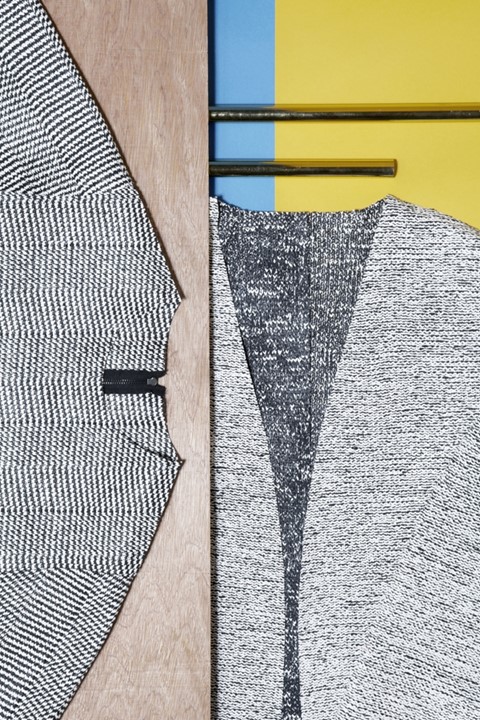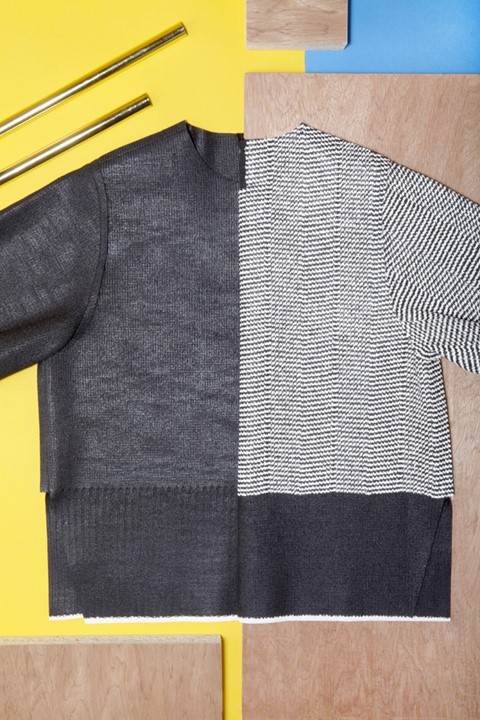We talk to Alice Gibberd, a recent graduate of the Royal College of Art MA, about her collection of women's knitwear.
"I hope people look at my pieces and ask: What is that? Is it woven, is it leather? I leave traditional knitwear clues – such as ribs or stitch structure – that lead to the realisation that it is in fact knit." This is Alice Gibberd’s elegantly understated take on women’s knitwear, which she presented as part of this year’s Royal College of Art Graduate Show. Her MA collection, a fine example of the innovation possible within the tradition of knitwear, proved how Gibberd has honed her craft since her Kingston University days. Slick and structured, the silhouettes showed a precisely defined vision of femininity that doesn’t need any decoration. Instead, it hinged upon simplicity of form executed in sophisticated materials and textures. Alongside images of her collection styled and shot by Baker&Evans, AnOther spoke to Gibberd as she embarks on her post-graduate future.
Have you always been interested in fashion?
No, although I always knew I wanted to work within the arts. Originally at school I wanted to be a painter, but as I developed I found I preferred the constraints of producing something functional. By merging concepts and life drawing, I started to create sculptural designs that changed the human form. This was the point at which I realised that I wanted to do fashion.
How did you decide upon the womenswear knitwear degree?
My love of knitwear comes from wanting an extra level of control. By taking the yarn and creating my own ‘fabric,’ everything about the process is mine. As a practical person I enjoy the physical act of producing samples on the knit machines, to capture my concepts. Right from the start these samples dictate the essence of the collection. The Womenswear Knit MA at the Royal College of Art meant I could focus on this love for sampling and really explore the possibilities within knit.
"My love of knitwear comes from wanting an extra level of control. By taking the yarn and creating my own ‘fabric,’ everything about the process is mine"
What do you enjoy most about the design process?
As I’m designing, each stage is my favourite. I love drawing and collaging from research images, developing the concept and then moving into sampling, which dictates the final garment. For me, the true height of the process is seeing my drawings come to life and to see the collection capture and communicate the initial concept.
How would you define your style?
My style is relaxed, pared down and innovative. I strive to create effortless, wearable garments, using a monochromatic palette to accentuate form. At the Royal College I have been interested in challenging the traditional perception of knitwear, producing a sleekness that’s not always associated with knit.
Who or what are your general influences?
My grandfather was the modernist architect Frederick Gibberd and although I never knew him, I was brought up within a family of architects and sculptors. I have been surrounded by creativity and therefore encouraged to develop my own aesthetic. I am naturally drawn to and influenced by architectural and sculptural forms, particularly looking at how light and dark are captured and the juxtaposition between soft tones and hard lines.

What has made the most impact on this collection?
Within my first few days at the Royal College I spent time rummaging through the yarn store and found polyurethane based yarn, which sparked a two-year investigation. My development of this material has had a huge impact on my collection and allowed me to represent sleek architectural lines in knitwear. I found that once knitted, the polyurethane could be heat-pressed, melting the fibres together, enabling it to be raw cut. I love the idea of making a notoriously fragile structure permanent, and this allowed me to reduce the design to its bare minimum.
Would you like to establish a brand of your own and how do you envision your own brand?
I would initially love to gain experience within the industry and work my way up within a high-end company. However, I would like to continue to work on my own label, producing small collections of pieces that can be commissioned to order.
What’s been the most exciting moment so far?
I wanted my work to look effortless, but when producing something so pared down there is no room for error. The simple aesthetic contradicts the hours and hours spent concentrating on the detail of each garment, every part needing to be sampled, redesigned and resolved several times. Therefore, the most exciting moment by far was seeing the collection come to life on the catwalk and seeing all that hard work pay off.

With special thanks to Swarovski, one of the sponsors of the Royal College of Art fashion show.
